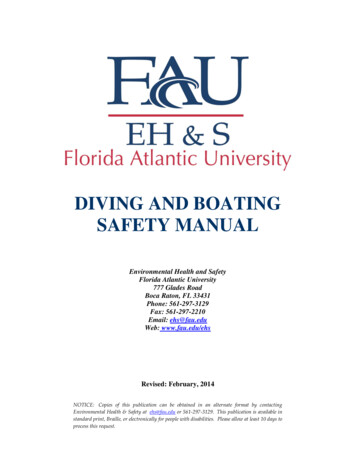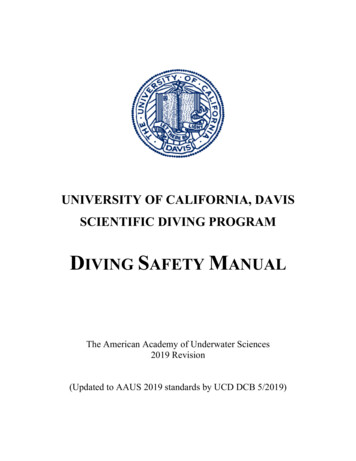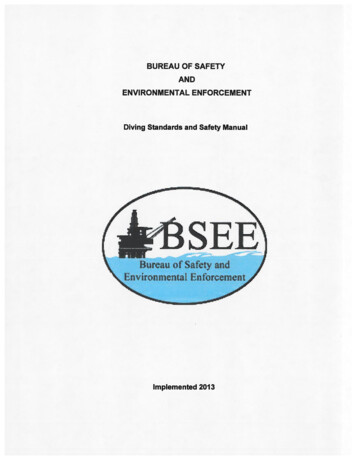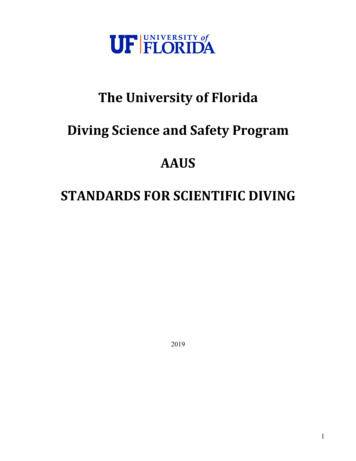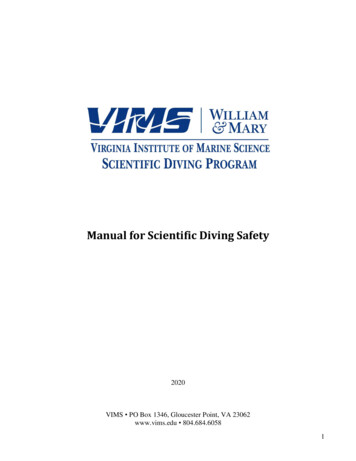
Transcription
Manual for Scientific Diving Safety2020VIMS PO Box 1346, Gloucester Point, VA 23062www.vims.edu 804.684.60581
2
FOREWORDThe Virginia Institute of Marine Science (VIMS) Scientific Diving Program has supported the VIMSDive Team with training and equipment since 1983. As an organizational member, we follow the latestAmerican Academy of Underwater Sciences (AAUS) Standards to safely conduct scientific divingoperations. This manual is a modified version of the 2018 AAUS Standards.ACKNOWLEDGEMENTSVIMS thanks the AAUS and the members of the VIMS community who, over the years, havecontributed to the contents of the VIMS Diving Safety Manual.Revision HistoryMarch 1983revised July 1987revised March 1990revised January 1998revised November 2017revised June 20193
ContentsSection 1.00 GENERAL POLICY .81.10 Scientific Diving Standards .81.20 Operational Control .91.30 Consequence of Violation of Regulations by Scientific Divers . 121.40 Consequences of Violation of Regulations by VIMS . 121.50 Record Maintenance . 12SECTION 2.00 DIVING REGULATIONS .132.10 Introduction . 132.20 Pre-Dive Procedures . 132.30 Diving Procedures . 142.40 Post-Dive Procedures . 152.50 Emergency Procedures . 152.60 Flying After Diving or Ascending to Altitude (Over 1000 feet/304 meters) . 162.70 Record Keeping Requirements . 16SECTION 3.00 DIVING EQUIPMENT .183.10 General Policy . 183.20 Equipment . 183.30 Auxiliary Equipment . 193.40 Support Equipment . 193.50 Equipment Maintenance . 19SECTION 4.00 SCIENTIFIC DIVER CERTIFICATION AND AUTHORIZATIONS .214.10 Prerequisites . 214.30 Diver Certification and Authorizations . 254.40 Depth Authorizations . 264.50 Maintaining Active Status . 264.60 Revocation of Authorization. 27SECTION 5.00 MEDICAL STANDARDS .275.10 Medical Requirements . 275.20 Frequency of Medical Evaluations. 275.30 Information Provided Examining Physician . 285.40 Content of Medical Evaluations . 284
5.50 Physician’s Written Report . 28Volume 2 . 29SECTION 6.00 NITROX DIVING .306.10 Requirements for Nitrox Authorization. 306.20 Minimum Activity to Maintain Authorization . 316.30 Operational Requirements . 316.40 Nitrox Diving Equipment . 32SECTION 7.00 Surface Supplied Diving Technologies .337.10 Prerequisites . 337.20 Hookah. 33SECTION 8.00 STAGED DECOMPRESSION DIVING .348.10 Minimum Experience and Training Requirements . 348.20 Minimum Equipment Requirements . 358.30 Minimum Operational Requirements . 35SECTION 9.00 MIXED GAS DIVING .37SECTION 10.00 REBREATHERS .3810.10 Definition . 3810.20 Prerequisites for use of any rebreather . 3910.30 Training . 3910.60 REBREATHER TRAINING SECTION . 43Appendices . 49APPENDIX 1 DIVING MEDICAL EXAM OVERVIEW FOR THE EXAMINING PHYSICIAN .50APPENDIX 2 AAUS MEDICAL EVALUATION OF FITNESS FOR SCUBA DIVING REPORT .52APPENDIX 2b AAUS MEDICAL EVALUATION OF FITNESS FOR SCUBA DIVING REPORT .53APPENDIX 3 DIVING MEDICAL HISTORY FORM .54APPENDIX 4 RECOMMENDED PHYSICIANS WITH EXPERTISE IN DIVING MEDICINE .57APPENDIX 5 DEFINITION OF TERMS .58APPENDIX 6 .63APPENDIX 7 EMERGENCY ACTION PLAN .64APPENDIX 8 AAUS STATISTICS COLLECTION CRITERIA AND DEFINITIONS .66Appendix 9 .70Recommendations For Rescue Of A Submerged Unresponsive Compressed-Gas Diver .705
6
7
Section 1.00 GENERAL POLICY1.10 Scientific Diving StandardsPurposeThe purpose of this manual is to ensure scientific diving is conducted in a manner that willmaximize the protection of scientific divers from accidental injury and/or illness, and to set forthstandards for training and certification that will allow a working reciprocity between VIMS andother Organizational Members (OMs or OM). Fulfillment of these purposes shall be consistentwith the furtherance of research and safety, and facilitation of collaborative opportunitiesbetween VIMS and other OMs.This Manual adheres to the minimum standards of the American Academy of UnderwaterSciences (AAUS) and the basic regulations and procedures for safety in scientific divingoperations. It also establishes a framework for reciprocity between VIMS and other OMs thatadhere to these minimum standards.Historical PerspectiveThis Manual was developed and modeled after the AAUS standards which were developed bycompiling the policies set forth in the diving manuals of several university, private, andgovernmental scientific diving programs. These programs share a common heritage with thescientific diving program at the Scripps Institution of Oceanography (SIO). Adherence to theSIO standards has proven both feasible and effective in protecting the health and safety ofscientific divers since 1954.In 1982, OSHA exempted scientific diving from commercial diving regulations(29CFR1910, Subpart T) under certain conditions that are outlined below. The final guidelinesfor the exemption became effective in 1985 (Federal Register, Vol. 50, No.6, p.1046). AAUS isrecognized by OSHA as the scientific diving standard setting organization.Scientific Diving DefinitionScientific diving is defined (29CFR1910.402) as:“Diving performed solely as a necessary part of a scientific, research, or educational activity byemployees whose sole purpose for diving is to perform scientific research tasks. Scientific divingdoes not include performing any tasks usually associated with commercial diving such as:Placing or removing heavy objects underwater; inspection of pipelines and similar objects;construction; demolition; cutting or welding; or the use of explosives.”Scientific Diving ExemptionIn following the AAUS Standards, the two elements that the VIMS dive program contains asdefined by OSHA in 29 CFR 1910 Subpart T 1910.401(a)(2)(iv) are:a) Diving safety manual which includes at a minimum: Procedures covering all divingoperations specific to the program; procedures for emergency care, includingrecompression and evacuation; and criteria for diver training and certification.b) Diving control (safety) board (DCB), with the majority of its members being activedivers, which must, at a minimum, have the authority to: Approve and monitor divingprojects; review and revise the diving safety manual; assure compliance with the manual;certify the depths to which a diver has been trained; take disciplinary action for unsafepractices; and, assure adherence to the buddy system (a diver is accompanied by and is in8
continuous contact with another diver in the water) for SCUBA diving.OSHA has granted an exemption for scientific diving from commercial diving regulations underthe following guidelines (Appendix B to 29 CFR 1910 Subpart T): The Diving Control Board consists of a majority of active scientific divers and hasautonomous and absolute authority over the scientific diving program’s operation. The purpose of the project using scientific diving is the advancement of science; therefore,information and data resulting from the project are non-proprietary. The tasks of a scientific diver are those of an observer and data gatherer. Construction andtrouble-shooting tasks traditionally associated with commercial diving are not includedwithin scientific diving. Scientific divers, based on the nature of their activities, must use scientific expertise instudying the underwater environment and therefore, are scientists or scientists-in-training.Recommendations for Changes to AAUS ManualAs part of VIMS’s annual report, recommendations for modifications of the AAUS Standardsmust be submitted to AAUS for consideration.1.20 Operational ControlVIMS Auspices and ResponsibilitiesVIMS auspices include any scientific diving operation in which VIMS is connected because ofownership of life support equipment used, locations selected, or relationship with theindividual(s) concerned. This includes all cases involving the operations of authorizedindividuals of VIMS or auxiliary organizations, where such individuals are acting within thescope of their authorization.It is the VIMS’s responsibility to adhere to the AAUS Standards for Scientific DivingCertification and Operation of Scientific Diving Programs. The administration of the local divingprogram will reside with the VIMS Diving Control Board (DCB).The regulations herein must be observed at all locations where scientific diving is conducted.VIMS Diving Safety ManualMeeting AAUS minimum standards is a requirement for VIMS to maintain organizationalmembership in the Academy. VIMS has developed and maintains a diving safety manual thatincludes wording and defines specific policies and procedures required for the proper function ofa its scientific diving program. VIMS has addressed environmental and working conditionsunique to its operations. The VIMS diving manual meets or exceeds the AAUS standards.AAUS standards must be the foundation for the development of an VIMS’s scientific divingsafety manual. The order and formatting of the VIMS manual mostly conforms to the AAUStemplate.Diving Control Board The Diving Control Board (DCB) consists of a majority of active scientific divers. Votingmembers include the Diving Safety Officer (DSO), and other representatives who are approvedby a vote of the DCB and appointed by the VIMS Dean and Director. The membership of theDCB will be reviewed no less than annually to confirm that all members meet the requirementsto remain on the DCB and are still committed to their responsibilities to the DCB. TheChairperson of the board will be elected on a biennial basis. The VIMS Chief Operations Officeris ex-officio, non-voting member.9
The DCB has autonomous and absolute authority over the scientific diving program’s operation.The DCB must:o Establish additional standards, protocols, and operational procedures beyond the AAUSminimums to address VIMS’s specific needs and concerns.o Approve and monitor diving projects, when requested by the DSO.o Review and revise the diving safety manual.o Ensure compliance with the diving safety manual.o Approve the depth to which a diver has been authorized to dive.o Take disciplinary action for unsafe practices.o Ensure adherence to the buddy system for scientific diving.o Act as the official representative of the VIMS in matters concerning the scientific divingprogram.o Act as a board of appeal to consider diver-related problems.o Recommend the issue, reissue, or the revocation of diving authorizations.o Recommend changes in policy and amendments to AAUS and the VIMS’s diving safetymanual as the need arises.o Establish and/or approve training protocols or standards through which the applicants forauthorization can satisfy the requirements of the VIMS diving safety manual.o Suspend diving operations considered to be unsafe or unwise.o Establish criteria for equipment selection and use.o Recommend new equipment or techniques.o Establish and/or approve facilities for the inspection and maintenance of diving andassociated equipment.o Ensure that the VIMS air station meets air quality standards as described in Section 3.60.o Annually review the VIMS Dive program.o Investigate diving incidents within the VIMS diving program or violations of the VIMSdiving safety manual.The DCB may delegate operational oversight for portions of the program to the DSO; however,the DCB may not abdicate responsibility for the safe conduct of the diving program.Diving Safety OfficerThe Diving Safety Officer (DSO) serves as a voting member of the DCB, and should bedesignated one of the VIMS Representatives to AAUS. This person should have broad technicalexpertise and experience in research related diving.Qualifications:1.Must be an active scuba instructor from an internationally recognized certifyingagency.2.Must be appointed by the responsible administrative officer or designee, with theadvice and counsel of the DCB.3.Must qualify as a Full Voting Member of AAUS as defined by AAUS Bylaws:“(a) Holds a diving certification from a recognized national certifying agency orequivalent, and(b) Has engaged in sustained or successive scientific diving activities during thepast two years, or(c) Has completed a course in scientific diving that meets the requirements asspecified by the most current edition of the AAUS Standards for ScientificDiving.”10
4.Must attend an AAUS DSO Orientation within one year of accepting a position at anAAUS approved OM, unless he/she has served as a DSO for another current AAUSOM within the last year.Duties and Responsibilities1.Answers, through the DCB, to the appropriate administrative officer or designee, forthe conduct of the scientific diving program of VIMS.2.If delegated by the DCB, the routine operational authority for this program rests withthe DSO. This oversight includes, but is not limited to: training, diver authorizations,approval of dive plans, maintenance of diving records, and ensuring compliance withthis Manual.3.May permit some duties and responsibilities to be carried out by a qualified delegate,with the approval of the DCB.4.Must be guided in the performance of the required duties by the advice of the DCB,but operational responsibility for the conduct of the scientific diving program will beretained by the DSO.5.Must suspend diving operations determined to be unsafe or unwise.Instructional Personnel QualificationsAll personnel involved in diving instruction under the auspices of VIMS must be reviewedand authorized by the DCB.Lead DiverFor each dive, one individual shall be designated as the Lead Diver who shall be at the divelocation during the diving operation. The Lead Diver shall be responsible for: Ensuring dives are conducted in accordance with Section 2.0.Ensuring all dive team members possess current authorization and are qualified for the typeof diving operation.Coordination with other known activities in the vicinity that are likely to interfere with divingoperations.Ensuring safety and emergency equipment is in working order and at the dive site.Suspending diving operations if in their opinion conditions are not safe.Reporting to the DCB, through the DSO, any physical problems or adverse physiologicaleffects including symptoms of pressure-related injuries.Reciprocity and Visiting Scientific Diver Two or more AAUS organizational members (OMs) engaged jointly in diving activities, orengaged jointly in the use of diving resources, must designate one of the participating DCBs togovern the joint dive project. However, responsibility for individual divers ultimately resideswith the home OM.A Scientific Diver from one OM must apply for permission to dive under the auspices of anotherOM by submitting to the DSO of the host OM a document containing all the information listed inAppendix 6, signed by the DSO or designee of the home DCB.A visiting Scientific Diver may be asked to demonstrate their knowledge and skills for theplanned dive.If a host OM denies a visiting Scientific Diver permission to dive, the host DCB must notify thevisiting Scientific Diver and their DCB with an explanation of all reasons for the denial.11
Waiver of RequirementsThe VIMS DCB may grant a waiver for specific requirements of training, examinations, depthauthorizations, and minimum activity to maintain authorizations. AAUS medical standards maynot be waived.1.30 Consequence of Violation of Regulations by Scientific DiversFailure to comply with the regulations of the VIMS Diving Safety Manual may be cause for therestriction or revocation of the diver’s scientific diving authorization by action of the VIMSDCB.1.40 Consequences of Violation of Regulations by VIMSFailure to comply with the regulations of the AAUS Standards may be cause for the restriction orrevocation of the VIMS’s recognition by AAUS.1.50 Record MaintenanceThe VIMS DSO maintains consistent records for its diving program and for each participant.These records include but are not limited to: diving safety manual; equipment inspection, testing,and maintenance records; dive plans (project and/or individual); records of dive (project and/orindividual); medical approval to dive; diver training records; diver authorization(s); individualdive log; dive incident reports; reports of disciplinary actions by the DCB; and other pertinentinformation deemed necessary by VIMS.Availability of Records: Medical records must be available to an attending physician of a diver or former diver whenreleased in writing by the diver.Records and documents required by this Manual must be retained by the VIMS DSO for thefollowing periods:1.Diving safety manual – Current document only.2.Equipment inspection, testing, and maintenance records – Minimum current entry ortag.3.Records of Dive – minimum of 1 year, except 5 years where there has been anincident of pressure-related injury.4.Medical approval to dive – Minimum of 1 year past the expiration of the currentdocument except 5 years where there has been an incident of pressure-related injury.5.Diver training records – Minimum of 1 year beyond the life of the diver’s programparticipation.6.Diver authorization(s) – Minimum of 1 year beyond the life of the diver’s programparticipation.7.Pressure-related injury assessment - 5 years.8.Reports of disciplinary actions by the DCB – Minimum of 1 year beyond the life ofthe diver’s program participation.12
SECTION 2.00 DIVING REGULATIONS2.10 IntroductionNo person shall engage in scientific diving operations under the auspices of the VIMSScientific Diving Program unless they are authorized pursuant to the provisions of thisManual.2.20 Pre-Dive ProceduresDive PlansBefore conducting any diving operations under the auspices of VIMS, a dive plan for theproposed project or dive must be formulated and submitted for approval by the DCB or designee.Dives should be planned around the competency of the least experienced diver. Furthermore, theVIMS Diving Program is often conducted in an estuarine environment. Limited to zero visibilityand considerable current are common diving conditions. These conditions vary dependent uponactual location within the Chesapeake Bay, Delmarva Coastal Bays and their tributaries.Therefore, authorization for Diver-In-Training to participate on dives will be made on a case-bycase basis by approval of specific dive plans. The dive plan (project or individual) should includethe following: Diving Mode(s) and Gas(es)Divers’ authorizationsApproximate number of proposed divesLocation(s) of proposed divesEstimated depth(s) and bottom time(s) anticipatedDecompression status and repetitive dive plans, if requiredProposed work, equipment, and boats to be employedAny hazardous conditions anticipatedEmergency Action Plan (Appendix 7)In water details of the dive plan should include:o Dive Buddy assignments and taskso Plan for communication between dive buddies – especially as it relates to low visibilityo Goals and objectiveso Maximum depth(s) and bottom timeo Gas management plano Entry, exit, descent and ascent procedureso Perceived environmental and operational hazards and mitigationso Predicted currents for dive site for dive timeo Emergency and diver recall proceduresDiver Responsibility and Refusal to DiveThe decision to dive is that of the diver. The ultimate responsibility for safety rests with theindividual diver. It is the diver’s responsibility and duty to refuse to dive, without fear ofpenalty, if in their judgment, conditions are unsafe or unfavorable, or if they would be violatingthe precepts of regulations in this Manual.No dive team member will be required to be exposed to hyperbaric conditions against their will.No dive team member may dive for the duration of any known condition, which is likely to13
adversely affect the safety and health of the diver or other dive team members.Pre-dive Safety Checks Prior to commencing the dive, the team must assure that every team member is healthy, fit,and trained for the type of dive that is being attempted.Scientific divers must conduct a functional check of their diving equipment in the presenceof the dive buddy or tender. They must ensure the equipment is functioning properly andsuitable for the type of diving operation being conducted.All dive gear must be worn and utilized as per the manufacture’s specification, and notimprovised or modified without the approval of the DSO and/or the DCB.Divers should avoid borrowing gear from other divers whenever possible unless theyhave extensive experience with a particular item. This is especially critical forregulators, BCD's and dry suits.Each diver must have the capability of achieving and maintaining positive buoyancy at thesurface.Environmental conditions at the site will be evaluated prior to entering the water. Theseinclude, but are not limited to the visibility, currents, waves, obstructions, temperature, andoccasional large aggregations of nuisance cnidarians.Pre-dive BriefingsBefore conducting any diving operations under the auspices of VIMS, the dive team membersmust be briefed on: Dive Buddy assignments and tasks Dive Buddy Communications Dive objectives. Maximum depth(s) and bottom time Turn around pressure and required surfacing pressure Entry, exit, descent and ascent procedures Perceived environmental and operational hazards and mitigations Methods of communication between buddies so that constant contacts is maintained Emergency and diver recall procedures2.30 Diving ProceduresSolo Diving ProhibitionAll diving activities must assure adherence to the buddy system. This buddy system is basedupon mutual assistance, especially in the case of an emergency. If loss of effectivecommunication occurs within a buddy team, all divers should surface and reestablish contact.Exceptions to this procedure can be made, upon approval, in the following situations: Extreme Shallow Water: Instances where SCUBA is used in shallow depths (less thanneck deep for an individual) simply as a matter of convenience also warrant specialconsideration. Provisions are hereby made to allow a single diver on SCUBA, providedthe depth is less than neck deep, and an individual prepared to enter the water (or alreadyin the water) remains in the immediate vicinity to assist in the event of difficulty. Thisdiving entails the use of HOOKAH rigs or backpacks and is primarily for work inshallow water seagrass habitats. Tethered SCUBA Diving: Instances best served by a single diver (low visibility, extremecurrents) warrant special consideration. Guidelines for this technique are available from14
the Diving Safety Office as a publication entitled Tethered SCUBA Diving. Theseguidelines require as a minimum a diver-to-surface communication system and astandby diver prepared to assist within one minute. Individuals are required to receivespecial training in this procedure. (Consult Diving Safety Office for further information.)Decompression Management On any given dive, both divers in the buddy pair must follow the most conservative dive profile A safety stop performed during the ascent phase of the dive should be conducted on any dive thatexceeds 30 feet (9.14m). All dives must be no-decompression dives, within no-decompression limits as set forth on U.S.Navy Dive Tables (or their equivalents), unless specifically authorized by the Diving ControlBoard.Termination of the DiveCylinder PressureAny dive must be terminated while there is still sufficient cylinder pressure to permit the diver tosafely reach the surface, including decompression time, or to safely reach an additional airsource at the decompression station. Divers also nee
Placing or removing heavy objects underwater; inspection of pipelines and similar objects; construction; demolition; cutting or welding; or the use of explosives." Scientific Diving Exemption In following the AAUS Standards, the two elements that the VIMS dive program contains as defined by OSHA in 29 CFR 1910 Subpart T 1910.401(a)(2)(iv) are:
